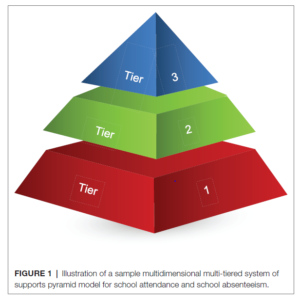Forth Valley and West Lothian Regional Improvement Collaborative
Attendance Focus: August -October 2022
Research Summary
| Research reference (with link) |
| Reconciling Contemporary Approaches to School Attendance and School Absenteeism: Toward Promotion and Nimble Response, Global Policy Review and Implementation, and Future Adaptability (Part 1)
Christopher A. Kearney1*, Carolina Gonzálvez2, Patricia A. Graczyk3 and Mirae J. Fornander1 Christopher A. Kearney1*, Carolina Gonzálvez2, Patricia A. Graczyk3 and Mirae J. Fornander1 |
| Research methodology / Data Collection methods |
| Part 1 reviews and critiques key approaches to school attendance and absenteeism with the purpose of providing a framework which can be used to promote school attendance in a flexible way depending on the context it is used in.
Part 2 sets out a framework for early prevention and intervention of attendance problems. |
| Key relevant findings |
| Part 1
Problems with school attendance are linked to internal behaviour problems such as anxiety, depression, suicide as well as external behaviour problems such as use of alcohol, drugs, poor peer relationships and involvement with the criminal justice system. “Students who drop out of high school are 24 times more likely than graduates to experience 4 or more negative life outcomes” (Landsford et al, 2016). School attendance problems have no consensus definition and can be complex due to the fact that risk factors for these are multi-layered. General definitions are grouped into a categorical (sorting students into defined groups to try to better understand the underlying behaviour) or dimensional approach (recognising the diversity and complexity of behaviours on a scale or continuum). The article examines the definitions of terminology relating to school attendance problems including truancy, school refusal, school phobia and school dropout (p3-6). Further research on the definitions and terminology around school attendance can be found in the summaries of the following research article: School non-attendance: definitions, meanings, responses, interventions, Dario W Pellegrini, March 2007. Through using a dimensional approach to school attendance a school should consider a spectrum from full presence to complete absence as shown in the diagram below.
Understanding early warning signs such as frequent requests to leave the classroom or avoidance of classes or areas of the school can be used to highlight potential absence problems before they arise. Kearney and Graczyk (2016) advocate the use of a Multi-tiered system of support (MTSS) model (see figure 2) to boost school attendance and address school attendance problems at different severity, risk factor and context levels. This model can be used flexibly and adaptably across a range of contexts and is based on evidence based best practice interventions.
Part 2 Following on from part 1, this article states the need for the design of a framework for school attendance which unites and blends both the categorical and dimensional approaches as they have overlapping qualities and purposes. The authors suggest that the Multi-tiered system of support model (MTSS) as suggested in part 1 can be further evolved to account for greater heterogeneity through used of a multi –tiered, multi-domain system of supports (MTMDSS). In this model the support is associated with multiple domains who are making simultaneous efforts to address the same issue (e.g educational psychology, school pastoral care staff, CAHMs etc). The used of a pyramid system rather than the 1 dimensional triangle shown in figure 2 allows for greater cross-sector working and enhances creativity and innovation in the use of preventative and intervention strategies. The base of the pyramid as shown in figure 3 focuses on promoting school attendance rather than preventing absenteeism. This involves consideration of factors such as work experience, smaller class sizes, access to mental health support, anti-bullying policies. The second tier of the pyramid is focused around early warning systems and nimble responses to absenteeism, perhaps through the use of screening such as data collection systems. Tier 3 approaches for students who are disconnected from school should focus on the opportunities for alternative pathways for career-readiness or use of virtual or project based learning to provide alternative or blended pathways.
As education and technology rapidly change use of a pyramid system to address problems with school attendance allows for flexibility and adaptability in responses through prevention and intervention.
|
| Questions research raises |
| How much do we focus on prevention of school attendance problems, compared to intervention once the problem has arisen?
Do we understand attendance problems on a spectrum or continuum that is changeable over time? Are our staff, pupils and parents aware of the negative future impact of non-attendance? |
| Follow up reading suggestions |
| Kearney, C. A. (2008). An interdisciplinary model of school absenteeism in youth to inform professional practice and public policy. Educ. Psychol. Rev. 20, 257–282. doi: 10.1007/s10648-008-9078-3
Kearney, C. A. (2016). Managing school absenteeism at multiple tiers: An evidence-based and practical guide for professionals. Oxford: New York. Stoiber, K. C., and Gettinger, M. (2016). “Multi-tiered systems of support and evidence-based practices” in Handbook of response to intervention. eds. S. Jimerson, M. K. Burns, and A. M. VanDerHeyden (Boston, MA: Springer), 121–141. Sugai, G., and Horner, R. H. (2009). Responsiveness-to-intervention and school-wide positive behavior supports: integration of multi-tiered system approaches. Exceptionality 17, 223–237. doi: 10.1080/09362830903235375 Xie, H., Chu, H. C., Hwang, G. J., and Wang, C. C. (2019). Trends and development in technology-enhanced adaptive/personalized learning: a systematic review of journal publications from 2007 to 2017. Comput. Educ. 140:103599. doi: 10.1016/j.compedu.2019.103599 Zaff, J. F., Donlan, A., Gunning, A., Anderson, S. E., McDermott, E., and Sedaca, M. (2017). Factors that promote high school graduation: a review of the literature. Educ. Psychol. Rev. 29, 447–476. doi: 10.1007/s10648-016-9363-5
|




